Salesforce Apex – Set
Set Creation
Generally, a set don’t allow duplicates and it is an unordered collection of items/elements. By utilizing the “Set” class, we create the set by specifying the variable name. We will discuss how to declare a Salesforce object with the set type while discussing the set methods in this guide.
Syntax:
Three scenarios can be possible to create a set. One is creating a set from the elements/items or from the sObject directly. We can create a new Apex set from the existing set of elements and existing list of elements.
Example 1: Creating a Set
We create two sets with “Integer” and “String” types and display the elements that are present in these two sets.
Set<Integer> ratings = new Set<Integer> {4,3,2,3,4,5,1,2,3};
system.debug('Ratings: '+ratings);
// Create set that hold three items of Type - String
Set<String> framework = new Set<String> {'Apex','LWC','Aura'};
system.debug('Frameworks: '+framework);
Output:
- The first set holds duplicate entries. A set won’t allow them. So, unique ratings are stored and returned.
- The second set don’t include duplicates. So, all are allowed in the set named “framework”.
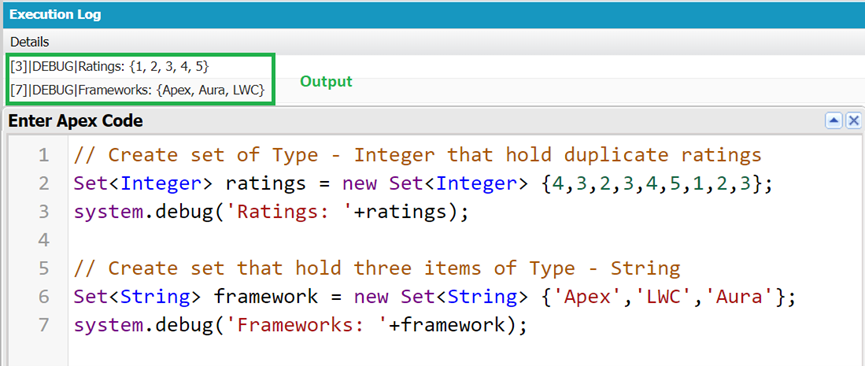
Example 2: Creating a Set from the Existing Set
Consider a set (framework1) with three strings. Declare another set (framework2) by assigning the first set to this set.
Set<String> framework1 = new Set<String> {'Apex','LWC','Aura'};
system.debug('Frameworks 1: '+framework1);
// Create framework2 from framework1
Set<String> framework2 = new Set<String> (framework1);
system.debug('Frameworks 2: '+framework2);
Output:
Now, the second set (framework2) holds all the elements of the first set (framework1).
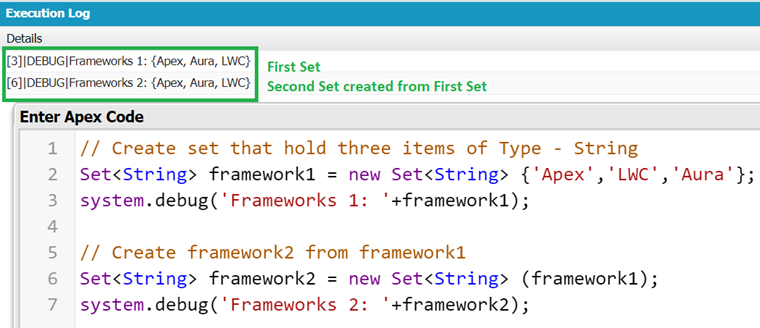
Example 3: Creating a Set from the Existing List
Consider a list (list1) with six strings that include three duplicates. Declare another set (set1) by assigning the list to the set.
List<String> list1 = new List<String> {'Apex','LWC','Aura','Apex','LWC','Aura'};
system.debug('List of Frameworks: '+list1);
// Create Set - set1 from List - list1
Set<String> set1 = new Set<String> (list1);
system.debug('Set of Frameworks: '+set1);
Output:
Now, the set holds only the unique elements of the list.
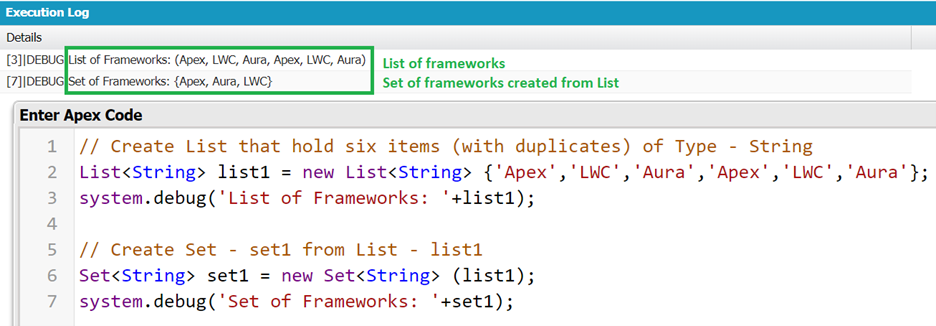
Adding Elements to the Set
It is possible to add single/multiple elements at a time to the set. The sources can be like list or set. We will discuss the methods that add the element/s to the set with examples.
Example 1: Add a Single Element
In Apex set, the add() method is used to add a single item to the set. If we pass the element that already exists in the set, it won’t be added.
Syntax: input_set.add(element)
Let’s create a set with three products and try to add two products to it.
Set set1 = new Set{'Books related','Kitchen items','Furniture'};
system.debug('Actual Set: '+set1);
// Add 2 items to the Set
set1.add('Electronic gadgets');
set1.add('Furniture');
system.debug('Final Set: '+set1);
Output:
Previously, the total number of elements in the set is 3. We add the “Electronic gadgets” and “Furniture” to the set. The “Furniture” is not added to the set as it already exists in the set. Now, the set holds four elements.
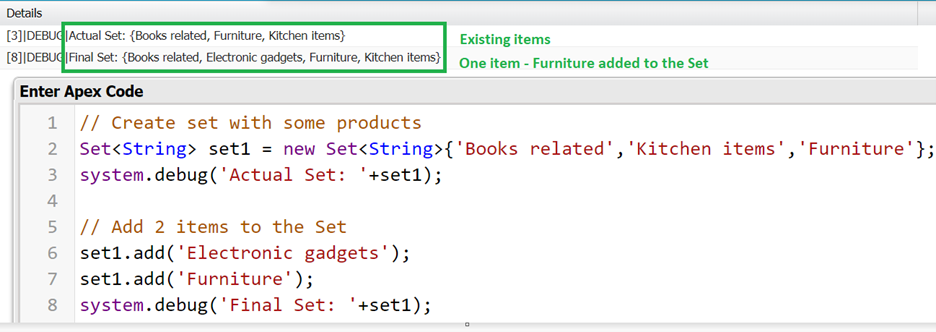
Example 2: Add Multiple Elements
The addAll() method takes the Apex set/list as a parameter such that all elements are added to the existing set. The elements are not added if they are contained in the existing set already.
Syntax:
- Adding the list items: input_set.addAll(List_name)
- Adding the set items: input_set.addAll(Set_name)
Let’s create a set (set1) and list (list1) with three products. Create two sets (new_set1, new_set2) and pass a set of values to the new_set1 and a list of values to the new_set2.
Set<String> set1 = new Set<String>{'Books related','Kitchen items','Furniture'};
system.debug('Actual Set: '+set1);
// Create list with some products
List<String> list1 = new List<String>{'Books related','Kitchen items','Kitchen items'};
system.debug('Actual List: '+list1);
// Create two empty sets.
Set<String> new_set1 = new Set<String>();
Set<String> new_set2 = new Set<String>();
// Add set1 to the new_set1
new_set1.addAll(set1);
system.debug('new_set1: '+new_set1);
// Add list1 to the new_set2
new_set2.addAll(list1);
system.debug('new_set2: '+new_set2);
Output:
The new_set1 holds three items which are created from the set (set1). The new_set2 holds only two items which are created from the list (list1) since one value is duplicated in the list.

Removing Elements from the Set
We can delete the elements from the Apex set using the remove() and removeAll() methods.
Example 1: Remove a Single Element
In Apex set, the remove() method is used to remove only the single element that is provided to it as a parameter.
Syntax: input_set.remove(element)
Let’s utilize the products set and remove “Furniture” from it.
Set<String> set1 = new Set<String>{'Books related','Kitchen items','Furniture'};
system.debug('Actual Set: '+set1);
// remove Furniture from set1
set1.remove('Furniture');
system.debug('Final Set: '+set1);
Output:
After removing “Furniture”, the set holds the “Books related” and “Kitchen” items.
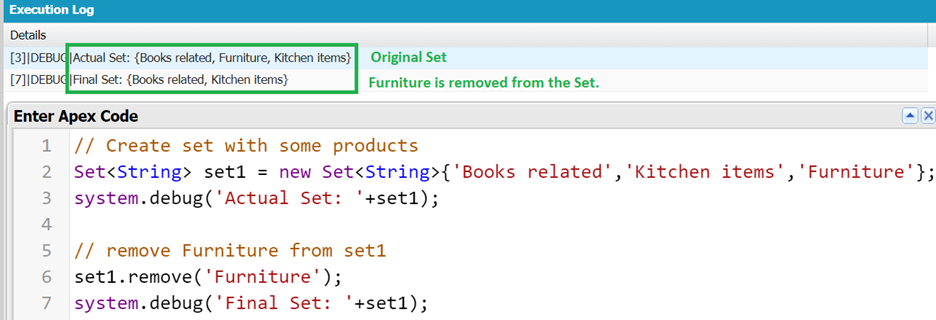
Example 2: Remove Multiple Elements
The removeAll() method takes the Apex set/list as a parameter such that the specified elements in the list/set are deleted from the existing set.
Syntax:
- Removing items from a set that exists in the list: input_set.removeAll(List_name)
- Removing items from a set that exists in the other set: input_set.removeAll(Set_name)
Let’s create a set (set1) and list (list1) with three products. Remove the elements from set1 that are in list1.
Set<String> set1 = new Set<String>{'Books related','Kitchen items','Furniture'};
system.debug('Actual Set: '+set1);
// Create list with some products
List<String> list1 = new List<String>{'Books related','Kitchen items'};
system.debug('Actual List: '+list1);
// Remove items from set1
set1.removeAll(list1);
system.debug('Final Set: '+set1);
Output:
Finally, the set holds only one item – “Furniture”.
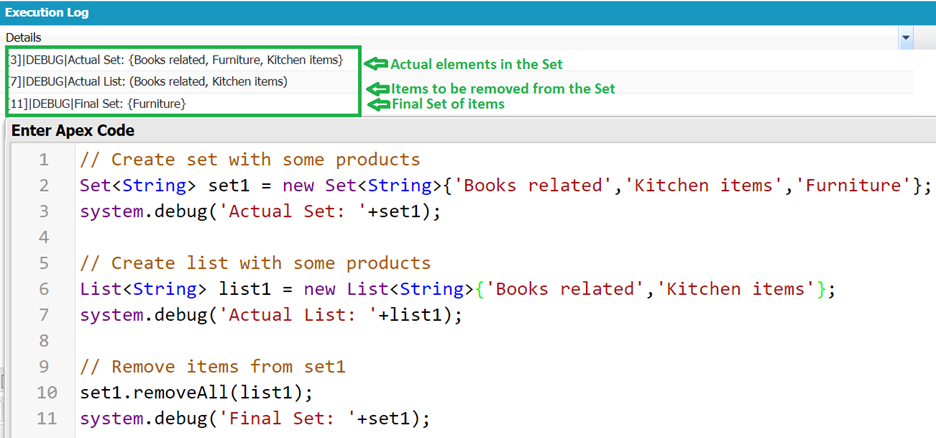
Other Methods
Example 1: Contains()
In Apex set, use the contains() method if you want to check whether the given element is present in the set. The “Method does not exist or incorrect signature” is raised if the wrong type is provided to this method. If an element is found, true is returned. Otherwise, false is returned.
Set<Integer> student_marks = new Set<Integer>{90,89,70,80,50,81,70};
system.debug('Set: '+student_marks);
// contains()
system.debug(student_marks.contains(40));
system.debug(student_marks.contains(60));
system.debug(student_marks.contains(80));
Output:
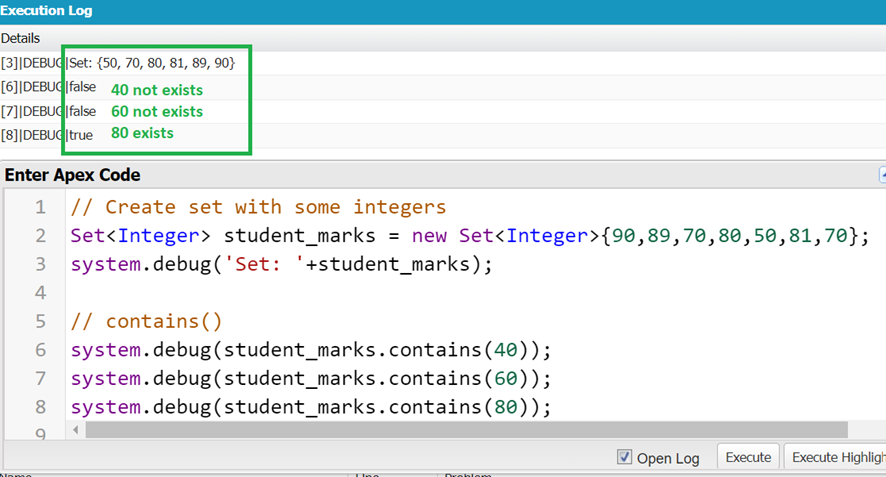
Example 2:
- The size() returns the total number of elements that are present in the set.
- The isEmpty() checks if the srt is empty or not. If it is empty, the Boolean value true is returned. Otherwise, false is returned.
- The equals() method returns true if all the elements in both sets are equal. Otherwise, false is returned.
Set<Integer> student_marks1 = new Set<Integer>{90,89,70,80,50,81,70};
Set<Integer> student_marks2 = new Set<Integer>{90,89,70,80,50,81,70};
// Check both sets are equal or not
system.debug(student_marks1.equals(student_marks2));
// Check if student_marks1 is empty or not
system.debug(student_marks1.isEmpty());
// return the size of student_marks1
system.debug(student_marks1.size());
Output:
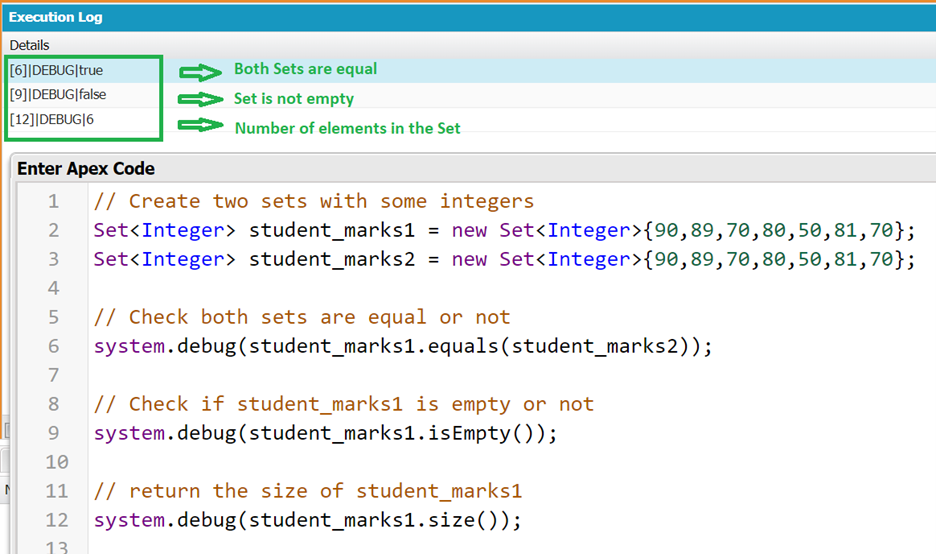
Conclusion
We learned how to utilize the set in Apex with simple examples. By utilizing the “Set” class, we create a set by specifying the variable name. A set can also be created from the list/set of elements. It won’t generate errors if you pass the duplicate elements, but these duplicates won’t be added to the set.
Source: linuxhint.com
